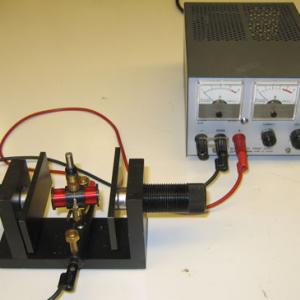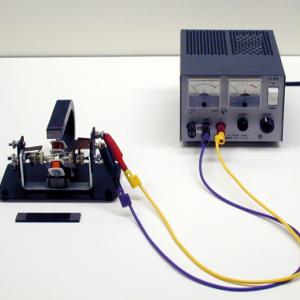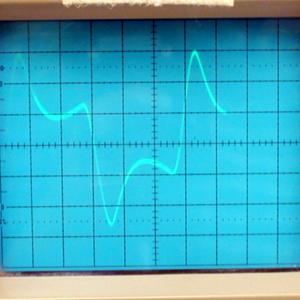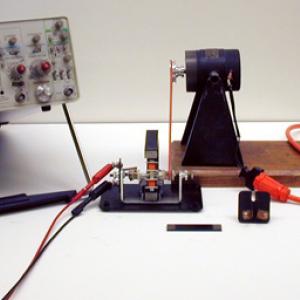College of Liberal Arts & Sciences
5K40.40 - St. Louis Motor - Generator
Hook the 0-20 VDC power supply to DC motor on the side with the split ring armature. When power is supplied this will run as a regular DC motor. Some adjustment of the horseshoe magnet may be required.
This demonstration uses the St. Louis apparatus as a generator. Use a large rubber band as a belt and put it on the split ring armature side of the motor. Connect the other end of the rubber band onto the small DC motor. Connect the oscilloscope to the AC side of the armature as we will be looking at the AC signal given off. Run the small DC motor at a fairly low rpm (about 6 volts) and observe that the AC signal given off is not a smooth sine wave.
You can run this as an AC or DC motor, or you can use it like a generator by rotating the armature and looking at either the AC or DC signal coming out.
NOTE: Remember that the side of the armature with the split ring is used for DC in or out, and the side with the two solid but separated rings is used for the AC in or out.
Other types of motor/generator configurations that can shown with this apparatus are: The Series Motor, The Shunt Motor, The Shunt Generator, The Series Generator, or a Universal Motor.
- Thomas B. Greenslade Jr., "The St. Louis Motor", TPT, Vol. 49, # 7, Oct. 2011, p. 424.
- "Figuring Physics", TPT, Vol. 41, # 5, May 2003, p. 303.
- Steve Dail, "Overheating Motor Demo", TPT, Vol. 41, # 8, Nov. 2003, p. 444.
- Thomas B. Greenslade Jr., "Genamotor", AJP, Vol. 91, #10, Oct. 2023, p. 854.
- George M. Hopkins, "Dynamic Electricity", Experimental Science, p. 471.
- "Four Toy Motors Convey Basic Ideas", The Boy Scientist, p. 119.
- B-405: "Jump Rope & Hand Crank Genecon", DICK and RAE Physics Demo Notebook.
- Joseph Frick, "# 315 - Electro-Magnetism as a Motive Power", Physical Technics: Or Practical Instructions for Making Experiments in Physics and the Construction of Physical Apparatus with the Most Limmited Means, p. 373.
Disclaimer: These demonstrations are provided only for illustrative use by persons affiliated with The University of Iowa and only under the direction of a trained instructor or physicist. The University of Iowa is not responsible for demonstrations performed by those using their own equipment or who choose to use this reference material for their own purpose. The demonstrations included here are within the public domain and can be found in materials contained in libraries, bookstores, and through electronic sources. Performing all or any portion of any of these demonstrations, with or without revisions not depicted here entails inherent risks. These risks include, without limitation, bodily injury (and possibly death), including risks to health that may be temporary or permanent and that may exacerbate a pre-existing medical condition; and property loss or damage. Anyone performing any part of these demonstrations, even with revisions, knowingly and voluntarily assumes all risks associated with them.



